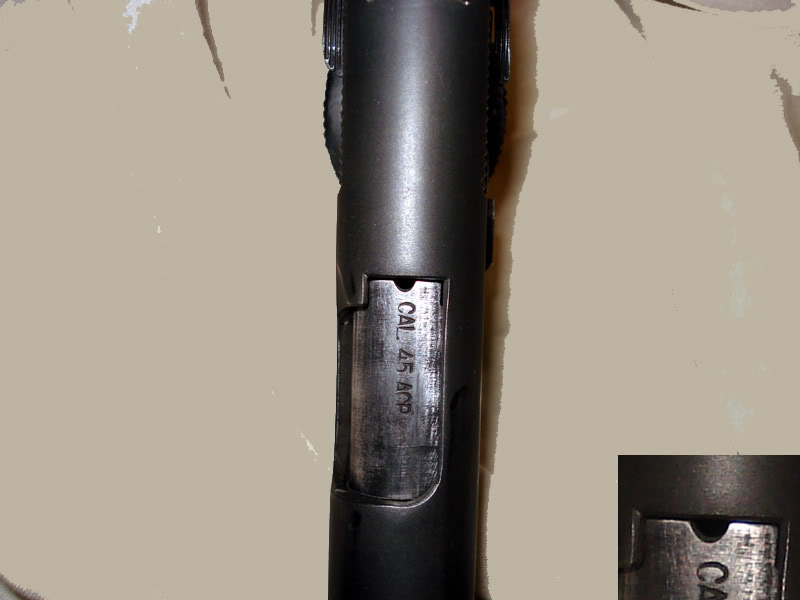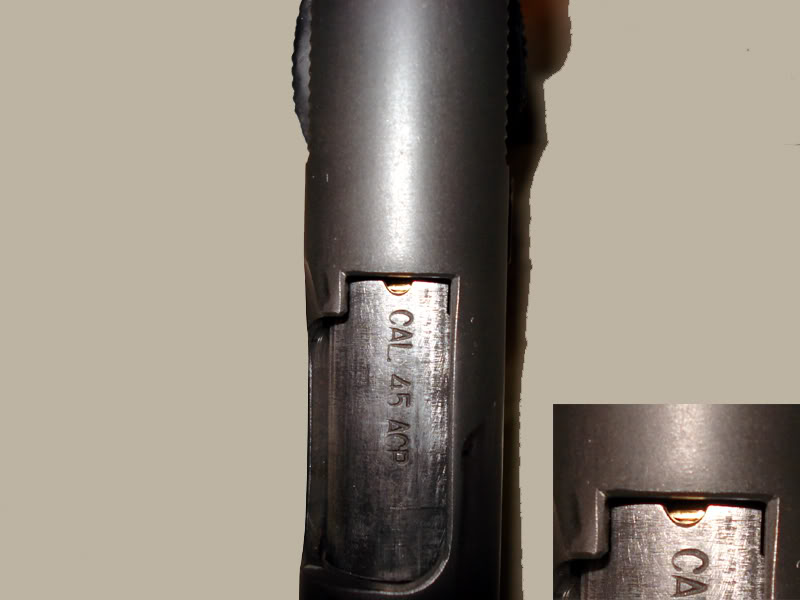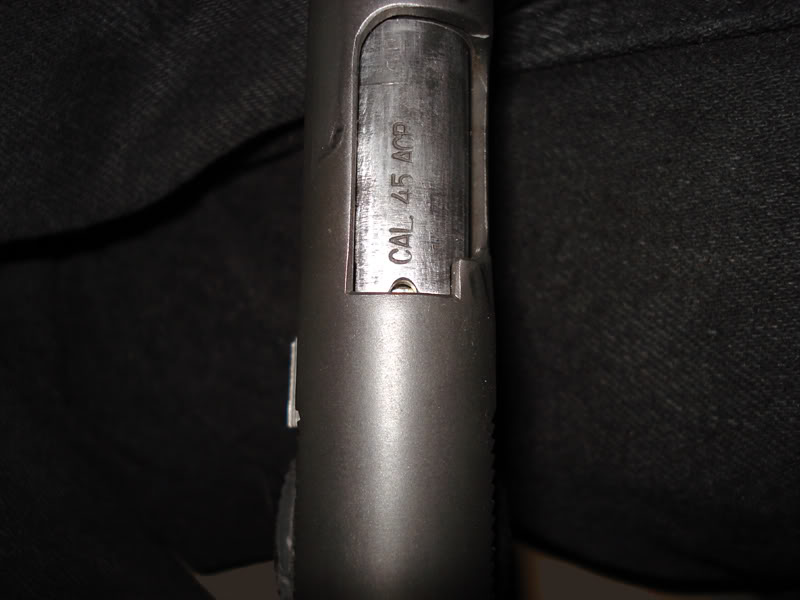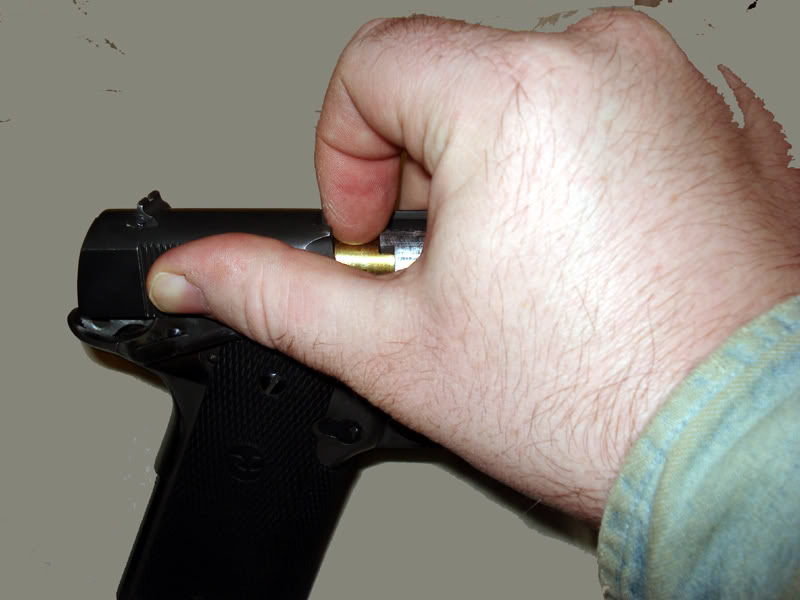
Some gunsmiths advocate milling a small witness hole in the barrel hood of a 1911 as a loaded chamber indicator. The man I'm thinking of mainly is Lauck.
I did this a while back and have had no problems.
There is someone taking me to task about it, telling me it allows too much stress.
The barrel hood, if the barrel is properly fitted, is about, what, .001" (going from memory here) away from the breech face when the barrel is in lockup.
There just isn't that much stress on the barrel hood at any time.
There's no internet resource on this that I can find.
I am very comfortable with the witness window, but apparently some are not.
I'd like your opinions and experiences. Has a witness window, serving as a loaded chamber indicator, milled into the barrel hood, been a problem for you? If so, why?
Several pistol manufacturers mill their barrel hoods to act as a loaded chamber indicator. As long as the opening is small, the edges are radiused to prevent stress risers leading to cracks in the barrel and it is cut where there is plenty of cartridge case thickness, I don't see a problem.
I've yet to hear of a barrel failure on one of these pistols due to having a loaded chamber indicator. I question the need for it but that is a different issue.
One time I went to work on the pistol. New grips or something.
I unloaded it, and found that the chamber was empty - I had either not racked it last time I loaded it, or short racked it. The hammer was back, so I'm not 100% sure what had happened.
I got into the habit of press checking when I put it on for the day, then again when I took it off.
I believe that the more you handle a firearm, doing checks and whatnot, the more likely the chance that one day an ND will occur. I prefer it for this reason alone, to keep from having to do press checks.
I suppose there's lots of ways to cut/machine the witness slot or hole in a barrel's hood, but whatever method is used I think it should be one which does not create or leave any residual stress in the hood - and possibly lead to crack initiation.
Don't, however, have the foggiest idea which of the possible methods would be the best or worst. Perhaps somebody else does (or knows if it really makes any difference!)
I just used a small needle file for the initial cut, and then radiused things up with some fine wet/dry sandpaper.
No speed involved, and the file cut clean with machine oil.
But I would not in any event trust any form of "loaded chamber" indicator. Some guns have them and some don't. There are various forms, including the witness slot in the barrel hood, which is small and hard to see in poor light and which can collect dirt, and mechanical devices, often part of an external extractor, that could malfunction.
The best way to verify the status of your weapon is to in some appropriate manner open the breach and visually and/or tactilely check the chamber. Yes, any time you handle your gun you risk an ND. That's why any time you handle your gun you need to pay attention to what you are doing. But personally, I'm just not going to trust any type of loaded chamber indicator.
Quote:
I just used a small needle file...
As a wild guess on my part, that method would leave about as little residual stress as possible. Needle file, huh? Did you count how many strokes it took?
Quote:
But I would not in any event trust any form of "loaded chamber"
indicator.
I totally agree. Springfield is one of that manufacturers that puts a small - less than an 1/8" - slot at the top rear of the barrel hood. Yes, if you look straight down in there you can often see the glint of brass, provided the light is right. How difficult is it to pull back on the slide a 1/2 inch of so and peek down and see if there's a round in the chamber or not? Not very.
I think Springfield (and the others) included this as a "feel good" measure, but how useful it really is remains in doubt.
Here's a handy way to do a press check that was taught in one of the classes I've taken and which I now use:
[1] Follow rule THREE and keep your finger off the trigger and outside the trigger guard.
[2] With the weak hand, grasps the slide with the thumb and middle finger on the rear serrations and the index finger resting on the barrel hood.
[3] Pull the slide back slightly. Something between a quarter and a half and inch should do it.
[4] Allow the index finger to drop down into the space between the end of the barrel hood and the breech face. If there was a round in the chamber, you will feel it.
Using this technique (1) you keep your hand far from the muzzle; (2) it doesn't matter whether your gun has front serrations; and (3) you don't have to look so it's useful in low light or if circumstances dictate that you keep your eyes elsewhere.
Give it a try.
I have an Auto Ordinance which comes with a notch in the barrel hood. At the time of purchase I was told this was done to make it Massachusetts compliant.
While I don't see a problem with most forms of chamber indicators, like the extrenal extractor ones (if the gun is already an external extractor design), my dislike to them is on the basis that some people like to use them as UNLOADED chamber indicators...
Quote:
[4] Allow the index finger to drop down into the space between the end of
the barrel hood and the breech face. If there was a round in the chamber, you
will feel it.
I agree with Frank. I much prefer the "Saint Thomas" approach when it comes to firearms. I gotta see the empty hole and stick my finger in there if need be.
If I look down and see brass, I know it's loaded.
If I look down and see black, I check.
I originally got the idea from Mr. Dave Lauck's book, which illustrates quite a bit more than just a small slit. It's actually a half moon that he uses.
Mine is in between:


loaded (with an empty case)
I wouldn't mind Lauck's version as it's wide enough to get a tactile indication as well, but I do not have the machinery to mill something that large out of a barrel hood.
I usually do not trust loaded chamber indicators either, but if I can actually see the brass as opposed to having something sticking out, an extractor or whatnot, telling me it's there, I'm OK with it.
The point is that it's not a substitute for the press check, but rather a supplement.
Make more sense as to why I want the thing?
Quote:
As a wild guess on my part, that method would leave about as little
residual stress as possible. Needle file, huh? Did you count how many strokes
it took?
200 initially, 50 more to get it just where I wanted it, 2 each top and bottom to clean up, then 100 each top and bottom with a dowel rod wrapped with 400 grit wet/dry sandpaper to chamfer the edges smooth.
Have I mentioned I'm a bit O.C.D.?
...and that probably contributes to my obsessive chamber checking too.
What works best for you IS what's best for you. As someone once said, "You can't always sometimes tell what you least expect to happen the most."
Quote:
It's still important to learn and practice doing a proper, safe chamber
check. Dirt can obscure the witness notch. Or, if you're using premium self
defense ammunition in nickle plated cases (or inexpensive practice ammunition
in aluminum or steel cases), a case in the chamber will be hard to see.
And of course, a witness notch is usable only in decent enough light (and/or for young eyes). Even Dave Lauck notes in his book: "In poor light conditions, however, the chamber will still have to be checked by feel..." (Lauck, The Tactical 1911, Paladin Press, 1998, pg 31). He then goes on to describe a technique, somewhat similar to the one I use, for manually checking the chamber tactilely.
I still prefer to do the manual visual/tactile chamber check, as I've described in a prior post, at all times. Some guns have witnesses notches, and some do not. Sometimes the light is good, and sometimes it is not. Sometimes I'm using ammunition with brass cases, and sometimes I'm using ammunition with nickel plated cases. Sometimes the gun is clean, and sometimes it is not. The manual visual/tactile chamber check works in all circumstances, and I prefer to do things the same way all the time.
Quote:
And if you're using nickle plated brass with an in-the-white or stainless
barrel, the witness holes are utterly useless.
No worries...

Nickel plated case, in this instance a Hydra-Shok. I have a light on a rheostat, and it's visible to a very low light level.
If there were no case in there, the slot would be black, like this:

This is a totally unloaded pistol.
As for press checks, here is my standard:

I grasp the whole slide, keeping my thumb on the rear grooves. This pistol has no front grooves.
And if I need tactile confirmation:

The way I press check allows my index finger to be free.
Btw, I'm a lefty - this is why everything appears done "backwards."
In the army, we were taught the following procedure for checking our guns (HK G3s) were empty and clear:
- Lock bolt open
- Put thumb (either one will do) through the ejection port onto the breechface
- Look down the barrel of the gun
Then:
If thumb is visible, chamber and barrel are clear
If thumb is obstructed, further investigation is necessary.
I don't recall any tips on low-light conditions. I DO recall some guys getting really sore thumbs and bloody fingernails, when the bolt was released accidentally and raced forward...
So all-in-all, probably a bad idea for everyday use.